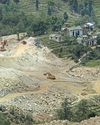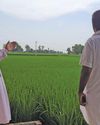Saving the black-necked cranes in India requires protecting its habitat.

THE BLACK-necked crane (BNC) is the only species of the crane family that lives on high altitudes. Perhaps due to the difficult terrain, inhospitable climatic conditions and inaccessibility, it is the last of the world’s crane species to be discovered in 1876 by a Russian naturalist, Nikolay M Przhevalsky, in the Chinghai province of China, and remained the least-known crane species till the 1960s.
BNC is a tall bird with a height of about 135 cm, a wingspan of about 62–64 cm and a conspicuous red crown on the head. The crane’s scientific name is Grus nigricollis, and it is distributed over the alpine regions of India, China and Bhutan. Buddhists consider it a sacred bird and a symbol of good luck. Bhutan celebrates the arrival of this flamboyant bird every winter, and it is also the state bird of Jammu & Kashmir. Its current population in the distribution range is between 10,000 and 11,000. Though it is stable and increasing, its presence in India is abysmal.
Bu hikaye Down To Earth dergisinin April 16, 2017 sayısından alınmıştır.
Start your 7-day Magzter GOLD free trial to access thousands of curated premium stories, and 9,000+ magazines and newspapers.
Already a subscriber ? Giriş Yap
Bu hikaye Down To Earth dergisinin April 16, 2017 sayısından alınmıştır.
Start your 7-day Magzter GOLD free trial to access thousands of curated premium stories, and 9,000+ magazines and newspapers.
Already a subscriber? Giriş Yap

A SPRIG TO CARE FOR
Punarnava, a perennial herb, is easy to grow and has huge health benefits

DIGGING A DISASTER
Soapstone mining near Dabti Vijaypur village has caused many residents to migrate.

REVIEW THE TREATMENT
Several faecal sludge treatment plants in Uttar Pradesh suffer from design flaws that make the treatment process both expensive and inefficient

MAKE STEEL SUSTAINABLE
As India works to double its GDP by 2030, its steel industry must balance growth with sustainability. By embracing policies like the Steel Scrap Recycling Policy 2019 and adopting green technologies, India is paving the way for a more sustainable future in steel production

Can ANRF pull off the impossible for India?
Anusandhan National Research Foundation is expected to reorient India's innovation goals but funding issues, old mindsets remain a drag

TROUBLED WOODS
Forests are a great bulwark against climate change. But this is fast changing. AKSHIT SANGOMLA travels through some of the pristine patches of the Western Ghats to explore how natural disturbances triggered by global warming now threaten the forest health

BLINDING GLOW
The science is clear: increased illumination has damaging consequences for the health of humans, animals and plants. It’s time governments introduced policies to protect the natural darkness and improved the quality of outdoor lighting.

GROUND REALITY
What happens when the soil loses the ability to grow healthy, high-yield crops on its own?

GM POLICY MUST BE FARMER CENTRIC
On July 23, the Supreme Court of India directed the Union government to develop a national policy on genetically modified (GM) crops for research, cultivation, trade and commerce through public consultation.

Vinchurni's Gandhi
A 96-year-old farmer transforms barren land into a thriving forest in drought-prone region of Satara